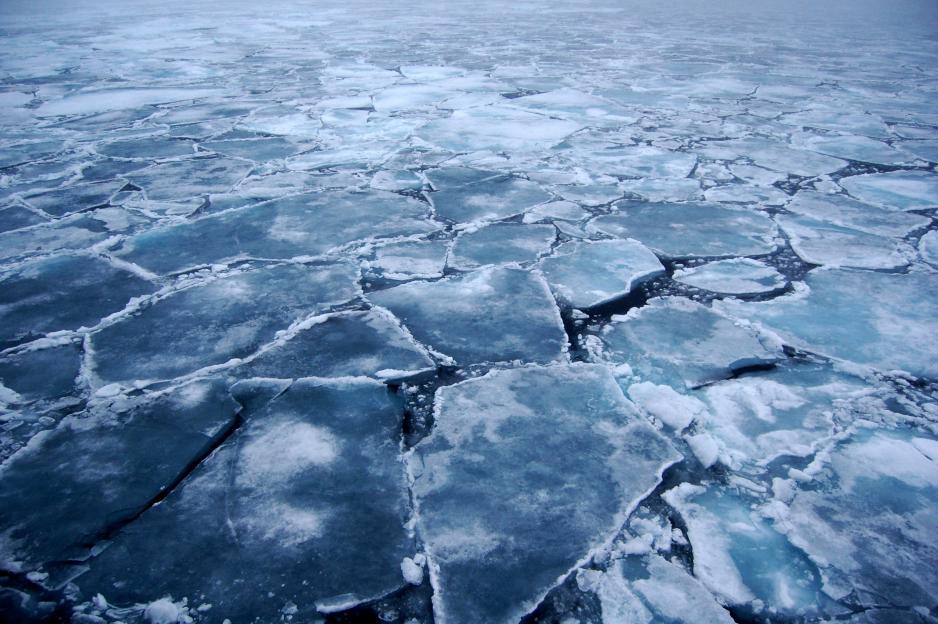Wintertime Sea Ice Growth Complicates the Arctic’s Big Melt Narrative

Sea ice in the Arctic Ocean. According to the 2018 NOAA Arctic Report Card, 95% of the Arctic’s oldest, thickest ice has already been lost. (Photo: Pink floyd88/Wikimedia Commons)
Arctic sea ice is melting at an alarming rate, but new research by NASA reveals a delay in its demise – ice is now thickening at a faster rate during winter.
Arctic sea ice usually finds itself in the news by way of its diminishing end-of-summer sea ice extent, which has almost halved since the early 1980s, or reports of its shrinking depth. Since 1958, Arctic sea ice cover has lost two-thirds of its thickness; today, roughly 70 percent of the ice cap is made of ice that forms and melts within a single year.
But last week, NASA’s Goddard Space Flight Center delivered some hopeful news just in time for the holidays – winter time Arctic sea ice growth is slowing its long-term decline.
Arctic Sea Ice Sees Wintertime Growth
According to a NASA press release, “New NASA research has found that increases in the rate at which Arctic sea ice grows in the winter may have partially slowed down the decline of the Arctic sea ice cover.” Using climate models and observations of sea ice thickness from the European Space Agency’s CryoSat-2 satellite to explore sea ice growth variability across the Arctic, NASA scientists determined that arctic sea ice has been thickening at a faster rate during winter since the 1980s.
The model simulations showed that in the 1980s, an extra 3.3 feet of ice would form over the winter compared to the average 6.6. feel thickness measured in October. That rate of growth has increased over the past three decades, and is expected to continue that trend for several more decades.
But the winter growth is not enough to counter the dramatic long-term trend of sea ice melt caused by a warming world. It merely slows its demise.
Understanding The Complexity of the Arctic’s Big Melt
The new data released by NASA nonetheless complicates the usual narrative of the Arctic’s big ice melt, raising questions about the sophisticated relationship between manmade and natural influences on the ice.
It’s that complex web of interactions between man, nature, and ice that Dr. Qinghua Ding and his colleagues Dr. Axel Schweiger and Dr. Ian Baxter of University of California Santa Barbara are trying to elucidate through better modeling.
“Understanding the relative contribution of natural and anthropogenic variabilities in recent sea ice loss is challenging since these two variabilities mix together in observations,” Dr. Qinghua explained to High North News. In a new paper published in Nature Geoscience, Dr. Quinghua and his team used a “finger-print pattern matching” technique to those two variabilities in Arctic sea ice measurements.

Dr. Qinghua Ding is an Assistant Professor at the Earth Research Institute at the University of California Santa Barbara and lead author of a new Arctic ice study. (Photo: University of California Santa Barbara)
Understanding The Complexity of the Arctic’s Big Melt
The new data released by NASA nonetheless complicates the usual narrative of the Arctic’s big ice melt, raising questions about the sophisticated relationship between manmade and natural influences on the ice.
It’s that complex web of interactions between man, nature, and ice that Dr. Qinghua Ding and his colleagues Dr. Axel Schweiger and Dr. Ian Baxter of University of California Santa Barbara are trying to elucidate through better modeling.
“Understanding the relative contribution of natural and anthropogenic variabilities in recent sea ice loss is challenging since these two variabilities mix together in observations,” Dr. Qinghua explained to High North News. In a new paper published in Nature Geoscience, Dr. Quinghua and his team used a “finger-print pattern matching” technique to those two variabilities in Arctic sea ice measurements.
Separating Human and Natural Influences on Ice
The Arctic model simulation, which included atmosphere, ocean and sea ice components, was forced by the same observed anthropogenic forcing in the historical record, beginning around 1920 and ending in 2015. Then, to fully simulate natural variability in the model, the simulation was repeated 40 times with different small disturbance added in the very beginning of each simulation.
“In this way,” Dr. Quinghua explains, “40 different climate scenarios could be obtained with each one forced by the same anthropogenic forging but also yielding different natural variability.”
So what did they find?
“Sea ice loss in the Arctic is a combination of anthropogenic and natural variability,” Dr. Quinghua and his team concluded. “Our study shows that models accurately reflect the local mechanism seen in observations linking circulation and temperature changes within the Arctic to sea ice loss.”
What Happens in the Tropics Doesn’t Stay in the Tropics
Still, Dr. Quinghua acknowledges that models do have trouble capturing the precise tropical-polar linkages and we must careful not to jump to conclusions when evaluating models using sea ice sensitivity. “Sea ice sensitivity links changes in Arctic sea ice with changes in global mean surface temperature,” he explains, “but results from this study show that connections between the Arctic and the rest of the globe may not be well captured in climate models.”
For example, models show the opposite relationship between changes in Arctic circulation and Pacific sea surface temperatures. “Model simulations show increased pressure and warming in the Arctic with warmer eastern Pacific sea surface temperatures. However, in observations we see increased pressure and warming in the Arctic with cooler eastern Pacific sea surface temperatures. These changes in Arctic circulation and temperature are modulated by atmospheric connections originating in the tropical Pacific.”
So what does this mean for the high north? A hackneyed truism: What happens in the Arctic doesn’t stay in the Arctic. Or, in the words of Dr. Quinghua, what happens in the tropics doesn’t stay in the tropics. “Our work puts further emphasis on linking the Arctic with the rest of the Earth. It also shows that when attempting to make projections of future Arctic climate change we must take into account the contributions from both natural and anthropogenic factors.”
